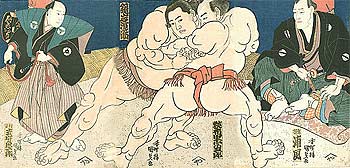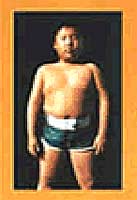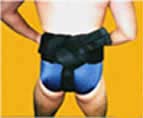The Tear Over Sumo Pants
By Christopher Caile
 |
Many young Japanese consider it immodest and non-stylish to
wear sumo’s traditional loin cloth which leaves the buttocks
exposed. It is thought that this has contributed to the decline
of the art
among youthful participants. |
3/28/05. Japanese sumo is in middle of a major tussle.
Contestants aren’t the gargantuan wrestlers you would expect, but
conservative tradition-bound elements versus amateur factions, the latter
seeking to boost the sports appeal among youngsters. The fight is over
one of sumo’s most famous symbols: the loincloth, known as mawashi,
which contestants wear around their broad naked midquarters.
The controversy made the front page of Yomiuri, Japan’s best selling
newspaper, on March 24, 2005.
  |
Front of rear views of the proposed amateur sumo pants worn under
the traditional mawashi, loin cloth. |
Faced with declining participation amongst kids, the Japanese Amateur
Sumo Federation voted to allow athletes to wear more modest “sumo
pants” under the traditional mawashi. The amateurs believe young
Japanese men avoid the sport because of the loincloths, which leaves
participants feeling uncomfortably exposed as they crouch down, buttocks
facing one another over the clay of the sumo ring known as dohyo.
Its vice-chairman, Hidetoshi Tanaka, stated that, “In this age,
young people on school holiday wear swimsuits in public baths. It is
understandable that many would not want to wear the mawashi on its own.”
Yomiuri quoted on amateur sumo official as saying, "Pubescent kids
are not going to want to take part if they don't look cool."
Amongst the Sumo community there is concern about the long term future
of the sport faced with declining membership among younger Japanese and
a national sports audience seemingly more attracted to non-indigenous
sports, such as baseball and football. In 2005 only 70 new professional
wrestlers were admitted to the sport compared to twice that number in
the early 1990’s.
But the Professional Japan Sumo Association, the Nihon Sumo Kyokai,
strong objected, refusing to allow youth tournament participants to wear
the proposed pant at the sport’s most prestigious location, the
Hall of the National Pursuit in the Ryogoku district of Tokyo. There
the clay of the ring (dohyo) is considered a sacred spot. Women are not
allowed to set foot on it. And the association that male wrestlers can’t
either if they wear the modest pants.
Yomiuri quoted a Professional Japan Sumo Association spokesman who stated, "The
national stadium has its rules and ways of doing things. We have no intention
of allowing children in pants into the ring."
This is not new. During last year’s high school national championships
in this hall, contestants who wore pants were compelled to remove them.
The proposed “sumo pants” are a tight, thigh-length garment,
which cover the wrestler’s buttocks as they crouch down to face
one another in the ring.
Manufacturers of sumo pants state that they are suitable for Japanese
sumo classes at elementary, junior, and senior high schools, as well
as universities. They were designed for both sexes and can be worn over
undergarments, with the mawashi on top, so multiple participants can
use the pants. They also allow provide tournament efficiency since they
can be reused in subsequent tournaments.
About the Author:
Christopher Caile is the Founder and Editor-In-Chief of FightingArts.com.
He has been a student of the martial arts for over 43 years. He first
started in judo. Then he added karate as a student of Phil Koeppel in
1959. Caile introduced karate to Finland in 1960 and then hitch-hiked
eastward. In Japan (1961) he studied under Mas Oyama and later in the
US became a Kyokushinkai Branch Chief. In 1976 he followed Kaicho Tadashi
Nakamura when he formed Seido karate and is now a 6th degree black belt
in that organization's honbu dojo. Other experience includes aikido,
diato-ryu aikijujutsu, kenjutsu, kobudo, Shinto Muso-ryu jodo, kobudo,
boxing and several Chinese fighting arts including Praying mantis, Pak
Mei (White Eyebrow) and shuai chiao. He is also a student of Zen. A long-term
student of one branch of Traditional Chinese Medicine, Qigong, he is
a personal disciple of the qi gong master and teacher of acupuncture
Dr. Zaiwen Shen (M.D., Ph.D.) and is Vice-President of the DS International
Chi Medicine Association. He holds an M.A. in International Relations
from American University in Washington D.C. and has traveled extensively
through South and Southeast Asia. He frequently returns to Japan and
Okinawa to continue his studies in the martial arts, their history and
tradition. In his professional life he has been a businessman, newspaper
journalist, inventor and entrepreneur.
|